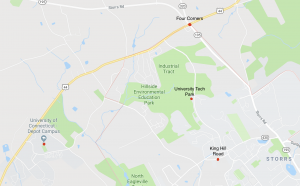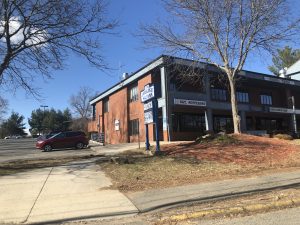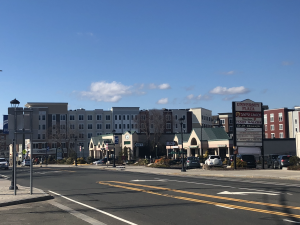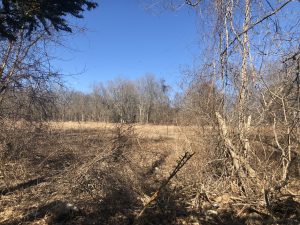By Ryan Bologna
April 14, 2019
University of Connecticut Newswriting II
There are about 9,000 federally designated opportunity zones in the country, 72 in Connecticut, and Mansfield is the only rural town in the state.
The Town of Mansfield and the University of Connecticut are collaborating with the Connecticut Economic Resource Center to determine what should be done in the opportunity zones. Spokesperson Stephanie Reitz said UConn is giving $25,000 to CERC in this collaboration. Mansfield Councilman David Freudmann said the town is giving $35,000 to CERC.
Town Manager Derrik Kennedy said the federally designated opportunity zones help certain selected areas in development and it is good news that Mansfield and UConn applied for and received an opportunity zone.
“It’s a really great thing,” Kennedy said. “Through the federal government’s tax act two years ago, now these opportunity zones were created. What it does is it provides high-net worth individuals across the country to invest in economic development jobs and infrastructure in these federally designated opportunity zones.”

Kennedy said he wants the town to lead the way and start a trend that other towns follow.
“I want to be the first town to really go forward with these opportunity zones and really make this a thing,” Kennedy said.
Freudmann said he is all for development until taxpayers are relied on.
“If the developers want to come and spend their own dime on it, I’m fine with it,” Freudmann said. “I’m all for development. I’m against taking from the taxpayer’s pocket to pay for it.”
The four areas of focused development are in the northwest quadrant of Mansfield. Four Corners and King Hill Road are the two areas on town property while the Mansfield Depot Campus and the university Tech Park are the two UConn properties.

Freudmann said that the template for Four Corners is the exact same one that was used for the Downtown Storrs area as well. He said that the project involved 3/4 million dollars just on preliminary work, and taxpayers are still paying for it today.

Kennedy said there is a lot of potential growth in the Four Corners area because of the recent extension of sewer and water lines to the intersection.
“Without the utilities, you’re not going to get a lot of growth on telling people that they are going to have to have their individualized septic tanks and try to figure out where they’re going to get their well water from,” Kennedy said. “Now with utilities there, they could just tap in like they’re in a city and go.”

Kennedy said Mansfield’s plan of conservation and development, which is a 10-year plan that every town is required to have, influenced the plans in Four Corners.
“We had to make sure that the zoning regs allowed for the proper development in that area that we were anticipating based on what the plan of conservation and development said they want it to be,” Kennedy said.
Over the course of the plan of conservation and development, the Four Corners area should look similar to how downtown Storrs does after residential and commercial development, Kennedy said.
Kennedy also said the opportunity zones will help decrease the town’s reliance on state aid, which is present because of all of the land that is not taxable because it is owned by UConn.
The opportunity zones might benefit UConn as well because of the development it would attract that it wouldn’t be able to do otherwise, Kennedy said.
“It might be that shot in the arm that UConn couldn’t do by itself in attracting entrepreneurs and other types of buildings that are going to go on your tech park.” Kennedy said.
Mayor Paul Shapiro said because of unique circumstances the town was able to receive an opportunity zone.
“Because the census tract that includes Four Corners includes our residence halls,” Shapiro said. “Students, even if they have rich parents, don’t have money. Because of that strange factoid, we became an opportunity zone. We applied for this designation. We were surprised.”
Shapiro said that building housing in Four Corners will help attract investors and benefit residents.
“If done right, Four Corners can work really well by offering multi-family housing, perhaps different options than [what is] available in Storrs Center, and it will take the burden off of those of us who pay residential property taxes,” Shapiro said.
Shapiro mentioned UConn faculty members developing technology as an example of potential investors, along with other options.
Reitz said there are no plans right now for the Mansfield Depot Campus and the University Tech Park, which are the two opportunity zones on UConn’s campus, but the university is making their best use of them in their current state.
“For now, we’re maximizing our use of several buildings with research and specialized engineering programs and would be open to ideas from the private sector as ways to use other parts of the property,” Reitz said.
Freudmann said he suspects that UConn would like the town to take over the Depot Campus property and he is concerned about contamination.
“UConn would love for the town to take it over,” Freudmann said. “It’s probably contaminated. I’m not claiming anything UConn did caused that. It’s from the old Mansfield Training School.”
CERC is meeting with property owners and advising the town council based on data analysis on what to do in these areas, Kennedy said.
After gathering all of the information on the opportunity zones, CERC will then give that to investors to get feedback on what they would be interested in doing, Kennedy said.
Freudmann said he had some concerns about the collaboration and is weary about UConn’s involvement with CERC.
“Why does the town have to get involved in it?” Freudmann said. “The very fact that UConn is kicking in $25,000 to this study. UConn wouldn’t give a dime to the town.”
Courtney Hendricson, vice president of municipal services at CERC, said that Mansfield is different compared to other areas that have been designated as opportunity zones.
“Mansfield is unique in that they are not only one of the few rural opportunity zones, but that the town is being proactive,” Hendricson said.
Hendricson said that CERC has met with property owners, UConn staff and local businesses seeking investment. The goal is to get a wide range of voices and allow them to tell CERC what they want to see done in the opportunity zones, she said.
William Rood, a Mansfield resident, was not fully familiar with the opportunity zones, but he said it is something that the town should jump on.
“It seems like a unique opportunity,” Rood said. “I don’t know all the ins and outs of how it works, but if there is a chance for the town to develop areas that they wouldn’t be able to on their own, then steps should be taken to take advantage of the opportunity.”
Rood also said that he remembers when Mansfield didn’t have the Downtown Storrs area and that more development like that would be a positive move for the town. He said other residents he knows might not be informed enough about what the opportunity zones mean.
Kennedy said he noticed other towns not taking as much action or taking advantage of these opportunity zones like Mansfield is.
“It’s such a huge deal,” Kennedy said. “A lot of towns I don’t think realize how big of a deal this is, and that’s why we’re trying to get out in front of it.”
Leave a Reply